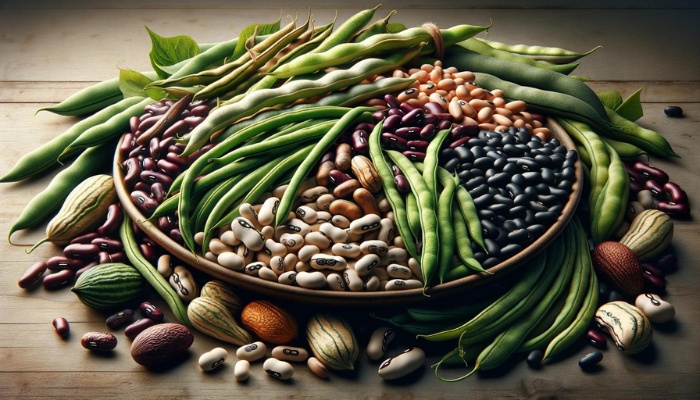Did you know that hydroponically grown beans can mature up to two weeks faster than their soil-grown counterparts? That’s an interesting statistic that highlights the efficiency and potential of hydroponic farming.
If you’re venturing into growing beans hydroponically, choosing the right variety is crucial, as is setting up your system correctly.
Nutrient solutions, environmental conditions, and proper harvesting techniques also play significant roles in ensuring a bountiful harvest.
Let’s explore some vital tips that will help you avoid common pitfalls and maximize your yield, ensuring your effort translates into success.
Choosing the Right Beans
Selecting the appropriate bean varieties is important for optimizing yield and performance in hydroponic systems. Research the specific characteristics of bean varieties to ensure they’re well-suited for the unique environment hydroponics offers.
It’s not just about what you want to grow, but what will grow best in your setup.
When you’re considering bean varieties, focus on those with proven adaptability and robust growth rates in hydroponic conditions.
Some varieties have been selectively bred to thrive in water-based cultivation systems, exhibiting faster germination rates and improved disease resistance.
Germination techniques are equally pivotal in this equation. You’ll want to employ methods that promote rapid and uniform sprouting.
For instance, pre-soaking beans can accelerate germination, but optimal temperature and moisture levels are critical variables that can significantly influence germination success.
Setting Up Your System
Once you’ve chosen the right bean varieties, design your hydroponic setup to meet their specific needs for optimal growth. Your system’s configuration plays a key role in determining the success of your harvest.
It’s essential to consider both the lighting options and system designs that best accommodate the growth habits and requirements of your selected beans.
Here are key components to focus on:
- Lighting Options: Select lighting that mimics the spectrum of sunlight. LED grow lights are efficient and can be adjusted to cater to the specific light frequency your beans need.
- System Designs: Several hydroponic systems, including Ebb and Flow, Deep Water Culture (DWC), and Nutrient Film Technique (NFT), are suitable for beans. Analyze each system’s mechanics, and choose one that aligns with your space, your budget, and the particular needs of your bean varieties.
- Spacing Requirements: Beans need ample space to grow. Ensure your system allows for adequate spacing between plants to prevent overcrowding and promote air circulation.
- Support Structures: Climbing bean varieties require vertical support. Incorporate trellises or stakes into your system design to facilitate upward growth and maximize space efficiency.
Nutrient Solutions Explained
Understanding the optimal nutrient solutions for your hydroponic beans is important for promoting vigorous growth and achieving maximum yields.
The composition of your solution directly impacts your plants’ health, dictating everything from root development to pod production.
You’ll need to adjust pH levels and solution concentration carefully to match the specific needs of your beans.
For pH levels, a range of 5.5 to 6.5 is ideal for hydroponic beans. This slightly acidic environment allows for optimal nutrient uptake because it keeps essential minerals soluble and readily available.
Maintaining pH within this range can significantly impact your beans’ growth rate and overall health.
Solution concentration, measured in electrical conductivity (EC), indicates the total soluble salts present in your nutrient solution. For hydroponic beans, an EC level ranging from 2.0 to 3.0 mS/cm is recommended.
This concentration ensures that your plants receive a balanced intake of nutrients without the risk of overfertilization, which can lead to nutrient burn and stunted growth.
Monitoring Environmental Conditions
Monitoring environmental conditions is critical for optimizing the growth and yield of your hydroponic beans because variations in temperature, humidity, and light intensity directly affect plant development and productivity.
To ensure your hydroponic beans thrive, focus closely on:
- Temperature Control: Maintain an optimal range between 65 and 70°F. Temperature fluctuations can stress plants, leading to poor growth or yield. Use digital thermometers for precise monitoring, and adjust heating or cooling systems as necessary.
- Humidity Management: Aim for a relative humidity of 40-60%. High humidity increases the risk of fungal diseases, while low humidity can stress plants. Use humidifiers or dehumidifiers to regulate the environment.
- Lighting Control: Ensure your beans receive adequate light, which is crucial for photosynthesis. Implement a lighting schedule that mimics natural sunlight patterns, using LED or HID lights. Adjust light intensity and duration based on the growth stage.
- Pest Management: Regularly inspect your plants for signs of pests or diseases. Implement preventive measures such as proper spacing and air circulation. Use nontoxic pest control methods to avoid harming your plants or the environment.
Harvesting and Maintenance
Harvesting at the right moment prevents the beans from becoming tough and flavorless. The beans should feel firm and snap easily when bent, signaling they’re ripe for picking.
Ongoing maintenance is an integral part of hydroponic growing. Implementing an integrated pest management (IPM) strategy is vital.
Start by closely monitoring for signs of pests, using sticky traps and visually inspecting plants.
If pests are detected, opt for biological controls like beneficial insects or apply nontoxic, organic pesticides as a last resort to minimize harm to your hydroponic ecosystem.
Pruning is equally important. Regularly removing dead or yellowing leaves enhances air circulation, reducing the risk of fungal infections.
Additionally, strategic pruning directs the plant’s energy toward producing more beans rather than excessive foliage. Use clean, sharp scissors to cut close to the stem without damaging the main plant structure.
This careful balance of pest control and pruning techniques, coupled with timely harvesting, will ensure your hydroponic beans thrive, promising a bountiful and quality yield.

